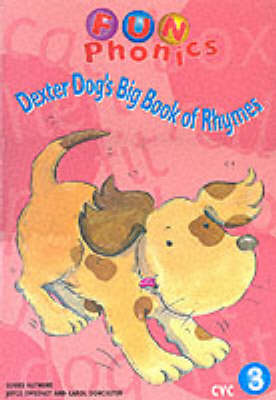Fun Phonics
7 total works
Hector Hedgehog’s Big Book of Rhymes (alphabet) uses alliteration to help children differentitate the initial sounds in words and to read the letters that represent the sounds.
Each of the four Big Books in Fun Phonics contains a wide selection of rhymes: traditional rhymes, alliterative rhymes which introduce the alphabet sounds as onsets, rhymes focusing on CVC words in the context of two lively stories, and rhymes focusing on consonant clusters as onsets.
Candy Cat’s Big Book of Rhymes (traditional rhymes) helps children follow the progression of rhyming skills outlined in the NLS and PiPS. These are: listen and enjoy; listen and join in; listen and anticipate; listen and identify rhyme; identify rhyme from a choice of three and volunteer words that rhyme with a given word.
Each of the four Big Books in Fun Phonics contains a wide selection of rhymes: traditional rhymes, alliterative rhymes which introduce the alphabet sounds as onsets, rhymes focusing on CVC words in the context of two lively stories, and rhymes focusing on consonant clusters as onsets.
Workbook 5 provides a resource to practise consonant clusters as onsets. it also gives practice in the different representations of long vowels and letter strings.
Fun Phonics Workbook 5 helps children build on skills learned in the whole class session. The activities extend their grasp of a new concept and provide opportunities to practise key skills such as:
- Identifying rhyming words from 3 choices given
- Developing understanding of relationships between initial sounds and their letter representation
- Combining understanding of onset and rhyme and phonemic blending
- Developing speed and accuracy in reading and writing
- Developing fluency in reading more complex onsets and rimes
Freda Frog’s Big Book of Rhymes (consonant clusters) gives practice in identifiying initial consonant clusters in words and reading the letters that represent these clusters. It provides a text for children to use a number of strategies to read.
Each of the four Big Books in Fun Phonics contains a wide selection of rhymes: traditional rhymes, alliterative rhymes which introduce the alphabet sounds as onsets, rhymes focusing on CVC words in the context of two lively stories, and rhymes focusing on consonant clusters as onsets.
Dexter Dog’s Big Book of Rhymes (CVC words) gives practice in blending phonemes to read CVC words in continuous text. This is in the form of two lively rhyming stories.
Each of the four Big Books in Fun Phonics contains a wide selection of rhymes: traditional rhymes, alliterative rhymes which introduce the alphabet sounds as onsets, rhymes focusing on CVC words in the context of two lively stories, and rhymes focusing on consonant clusters as onsets.
Fun Phonics is direct instruction at its best. The Teacher’s Handbook is everything you need to teach phonics skills confidently, whatever your phonics training. It provides a systematic, structured teaching programme with a balanced ‘no jargon’ approach to phonics teaching. It is referenced to the NLS with a simple but comprehensive finger index.
Each lesson has the following features:
Before You Start : pre-lesson preparation
The Lesson: 15 minutes long, each lesson develops the course incrementally as the programme progresses. Questioning techniques are recommended to ensure full pupil participation. Lessons contain activites such as learning about rhyme, developing phonemic awareness, alphabet naming activities, and blending and segmenting.
Further Practice: suggestions for consolidation and reinforcement of skills learned.
Planning: An index links each lesson to the NLS by year/term reference, key skill and specific skill.


